How To Say Chopsticks In Japanese
Chopsticks: read a history of chopsticks in Japan including the dissimilar styles and uses of Japanese chopsticks.
Nihon's Chopsticks 箸
by Alan J. Wiren
What do you normally eat with?
If your answer is not, "My hands," then you vest to one of 2 minorities on this planet. 30 percent of us usually consume with cutlery. Another xxx percent use chopsticks.
How the Japanese began to utilise chopsticks is a subject of fence. Some say chopsticks wended their way, along with other facets of culture, from China, through Korea, to Nippon around the sixth century Advertizing. Others, that they were brought direct back to Japan past an royal envoy at a somewhat later appointment. In whatever case, like many things that came from China to Japan, chopsticks were initially revered.
The Japanese word for "chopsticks" is hashi which is a homophone with the Japanese word meaning "span". The concept of chopsticks providing a bridge is a recurring motif in Japanese culture, reflected in distinctive shapes and materials that vary with the occasions of their use.
In their early history, Japanese chopsticks provided a bridge between the human and the divine. Rather than for taking ordinary meals, they were used, at first, for sharing food with the gods. It was believed that when a pair of chopsticks was offered to a deity, the chopsticks became inhabited by that deity. When those chopsticks were used to eat the food that was offered along with them, mortal and immortal dined together.
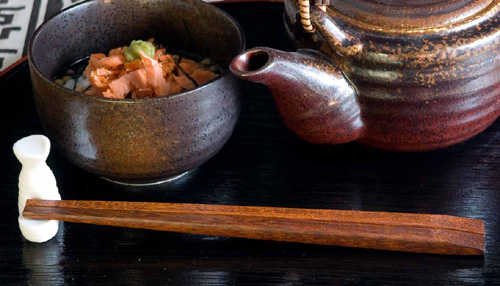
Dissimilar their Chinese precursors, of uniform thickness, Japanese chopsticks are tapered along their length. The chopsticks used for ceremonial purposes are tapered on both ends. Akira Izu explained when I visited his chopstick museum in Kyoto, "The gods said, 'I end is for you, the other is for u.s..'"
This kind of ceremonial chopstick is nonetheless in apply in Japan, today. One venue is the formal tea ceremony. The form of the tea ceremony was crystallized by the seventeenth century tea master, Senno Rikyu, who prescribed a calorie-free repast before sharing tea. It is said that Rikyu would carve new chopsticks, himself, from a fresh cake of cedar before his guests would arrive. These had tapered, rounded ends and a squared off middle section so as to be held easily. This style of chopsticks still bears Rikyu's proper noun and is used for the tea ceremony and in many restaurants.
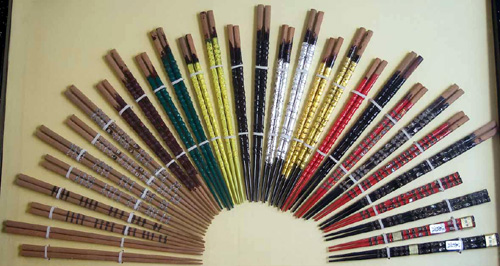
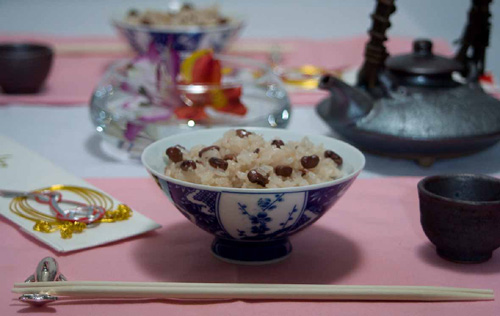
You volition also detect ceremonial chopsticks used in Japanese homes during New year's day celebrations. They are fabricated from lite colored woods, with a circular cross-department throughout. It is common, at a big family gathering, for each member to receive his or her own gear up of these chopsticks to utilise throughout the holiday menstruation. Following the holidays these chopsticks are ofttimes taken to a temple and burned in a fire maintained for that purpose.
The custom of individuals using their own pair of chopsticks is not simply for the holidays. Chopsticks gradually took their place, in Japan, as a bridge betwixt serving vessels and the mouth in ordinary meals. Different Chinese families, who keep a collection of a dozen or and then identical chopsticks in a box or a big cup on the dining table, Japanese families tend to keep personal pairs of chopsticks for each family member.
Japanese chopsticks for every 24-hour interval use are tapered at merely the cease used to grasp the food, and can be found in vast variety. At the beginning of the seventeenth century the people of Wakasa (an area along the Japan Body of water coast) began to utilise lacquer to chopsticks. This made them more slippery, but longer lasting. Lacquered chopsticks from Wakasa are amid the most traditional styles. They may be dusted with powdered seashells, or coated with several layers of different colored lacquer which are and then sanded through to produce multicolored patterns. Other prefectures produce chopsticks featuring the materials or techniques they are known for such as inlays of shells or intricate carving techniques.
Modernistic designs may include your astrological sign (Eastern or Western), the flora or brute of the seasons, or popular animation characters. Some stores in Nippon are devoted exclusively to the sale of chopsticks. They offering diverse designs for eating foods ranging from needle sharp points for fish, to spiraled tips for spaghetti, to about paddle-similar ends for ochazuke (rice covered with green tea).
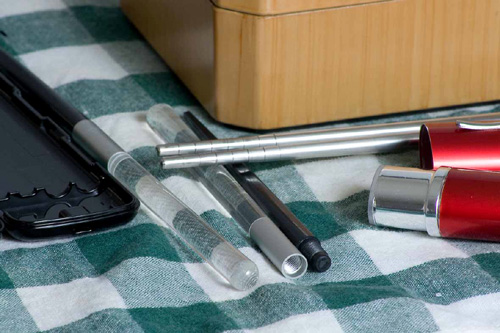
Y'all can find chopsticks made of ivory, bone, or plastic, merely wood is the well-nigh common fabric. Willow is oft called for a wedding gift because it is long lasting. The Yoshino area, in Nara prefecture, is known for its cedar forests and as the origin of waribashi, "dispensable chopsticks". During the seventeenth century, Yoshino was a production centre for sake barrels and began turning the leftover scraps into the kind of chopsticks that are at present commonly found in restaurants all over the nation. Waribashi are fabricated from a single piece of wood, partially divide in the middle. The end user completes the splitting by pulling apart the two halves.
At that place is some controversy over disposable chopsticks. Some fence that, since they are made, fifty-fifty today, from scrap wood, they pose no threat to the environment. While this is true of waribashi fabricated in Japan, it is estimated that ninety per centum of the disposable chopsticks used in Japan are made in China, where trees are harvested for that unmarried purpose.
A recent invention has eased the minds of both those who are concerned with the preservation of natural resources and those who feel squeamish about chopsticks that take been previously used by strangers. Tsunagibashi (literally "connecting chopsticks") are chopsticks with a socket halfway through their length so they cam exist taken apart and fit into a convenient conveying case, to go anywhere with their owners. Connecting chopsticks are a thoughtful souvenir for the eco-friendly traveler.
Japanese chopsticks accept besides been made from silver and golden, especially for use in imperial households where food tasters were employed. There was a time when information technology was believed precious metals would turn black when in contact with sure poisons. Japan'due south royalty may take lost some of its food tasters to this myth.
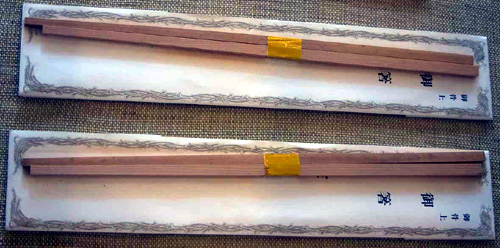
And speaking of death brings us back to the ceremonial utilise of chopsticks. Cremation is nearly universal in modern-solar day, Japanese funerals. The body, however, is not reduced entirely to ash. It is customary for the extended family to transfer the bones of the deceased into an urn with chopsticks. Funerary chopsticks are tapered at simply one stop, simply are quite different for those used at table. One is made from bamboo and one from forest, representing the elements of water and fire, thus creating a bridge betwixt this world and the next.
In the Japanese fashion of thinking, there is a lingering sense of the divine in any pair of chopsticks. A pair of your ain, inhabited by memories fabricated in Japan, tin can span the gap betwixt the present and the past.
Text and Photos by Alan Wiren
Other articles on Japan by Alan Wiren
Books on Nihon
Source: https://www.japan-experience.com/plan-your-trip/to-know/understanding-japan/chopsticks

0 Response to "How To Say Chopsticks In Japanese"
Post a Comment